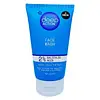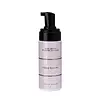What's inside
What's inside
 Key Ingredients
Key Ingredients

 Benefits
Benefits

 Concerns
Concerns

 Ingredients Side-by-side
Ingredients Side-by-side

Salicylic Acid 2%
MaskingWater
Skin ConditioningCocamidopropyl Betaine
CleansingDecyl Glucoside
CleansingGlycerin
HumectantDisodium Cocoamphodiacetate
CleansingAcacia Concinna Fruit Extract
Skin ConditioningAloe Barbadensis Leaf Juice
Skin ConditioningGypsophila Paniculata Root Extract
Skin ConditioningChrysanthemum Parthenium Extract
Skin ConditioningCitrus Aurantium Dulcis Fruit Extract
MaskingCucumis Sativus Fruit Extract
EmollientSea Whip Extract
Skin ConditioningChamomilla Recutita Flower Extract
MaskingElettaria Cardamomum Seed Extract
PerfumingLavandula Angustifolia Flower/Leaf/Stem Extract
MaskingCitrus Aurantium Dulcis Peel Extract
Emulsion StabilisingEugenia Caryophyllus Flower Extract
AstringentGardenia Taitensis Flower Extract
Skin ConditioningHibiscus Abelmoschus Seed Extract
MaskingPrunus Armeniaca Fruit Extract
Skin ConditioningPyrus Malus Fruit Extract
Skin ConditioningVanilla Planifolia Fruit Extract
Skin ConditioningHedychium Spicatum Extract
Skin ConditioningJasminum Officinale Flower/Leaf Extract
MaskingPlumeria Rubra Flower Extract
Skin ConditioningAscorbyl Palmitate
AntioxidantRetinyl Palmitate
Skin ConditioningTocopheryl Acetate
AntioxidantCocamidopropyl Pg-Dimonium Chloride Phosphate
PEG-9 Dimethicone
Skin ConditioningPhospholipids
Skin ConditioningGlucose
HumectantLactic Acid
BufferingCaprylic/Capric Triglyceride
MaskingPanthenol
Skin ConditioningBalanites Aegyptiaca Fruit Extract
Bisabolol
MaskingEthoxydiglycol
HumectantPropylene Glycol
HumectantButylene Glycol
HumectantXanthan Gum
EmulsifyingDisodium EDTA
Salicylic Acid 2%, Water, Cocamidopropyl Betaine, Decyl Glucoside, Glycerin, Disodium Cocoamphodiacetate, Acacia Concinna Fruit Extract, Aloe Barbadensis Leaf Juice, Gypsophila Paniculata Root Extract, Chrysanthemum Parthenium Extract, Citrus Aurantium Dulcis Fruit Extract, Cucumis Sativus Fruit Extract, Sea Whip Extract, Chamomilla Recutita Flower Extract, Elettaria Cardamomum Seed Extract, Lavandula Angustifolia Flower/Leaf/Stem Extract, Citrus Aurantium Dulcis Peel Extract, Eugenia Caryophyllus Flower Extract, Gardenia Taitensis Flower Extract, Hibiscus Abelmoschus Seed Extract, Prunus Armeniaca Fruit Extract, Pyrus Malus Fruit Extract, Vanilla Planifolia Fruit Extract, Hedychium Spicatum Extract, Jasminum Officinale Flower/Leaf Extract, Plumeria Rubra Flower Extract, Ascorbyl Palmitate, Retinyl Palmitate, Tocopheryl Acetate, Cocamidopropyl Pg-Dimonium Chloride Phosphate, PEG-9 Dimethicone, Phospholipids, Glucose, Lactic Acid, Caprylic/Capric Triglyceride, Panthenol, Balanites Aegyptiaca Fruit Extract, Bisabolol, Ethoxydiglycol, Propylene Glycol, Butylene Glycol, Xanthan Gum, Disodium EDTA
Ingredients Explained
These ingredients are found in both products.
Ingredients higher up in an ingredient list are typically present in a larger amount.
Cocamidopropyl Betaine is a fatty acid created by mixing similar compounds in coconut oil and dimethylaminopropylamine, a compound with two amino groups.
This ingredient is a surfactant and cleanser. It helps gather the dirt, pollutants, and other impurities in your skin to be washed away. It also helps thicken a product and make the texture more creamy.
Being created from coconut oil means Cocamidopropyl Betaine is hydrating for the skin.
While Cocamidopropyl Betaine was believed to be an allergen, a study from 2012 disproved this. It found two compounds in unpure Cocamidopropyl Betaine to be the irritants: aminoamide and 3-dimethylaminopropylamine. High-grade and pure Cocamidopropyl Betaine did not induce allergic reactions during this study.
Learn more about Cocamidopropyl BetaineGlycerin is already naturally found in your skin. It helps moisturize and protect your skin.
A study from 2016 found glycerin to be more effective as a humectant than AHAs and hyaluronic acid.
As a humectant, it helps the skin stay hydrated by pulling moisture to your skin. The low molecular weight of glycerin allows it to pull moisture into the deeper layers of your skin.
Hydrated skin improves your skin barrier; Your skin barrier helps protect against irritants and bacteria.
Glycerin has also been found to have antimicrobial and antiviral properties. Due to these properties, glycerin is often used in wound and burn treatments.
In cosmetics, glycerin is usually derived from plants such as soybean or palm. However, it can also be sourced from animals, such as tallow or animal fat.
This ingredient is organic, colorless, odorless, and non-toxic.
Glycerin is the name for this ingredient in American English. British English uses Glycerol/Glycerine.
Learn more about GlycerinSalicylic Acid (also known as beta hydroxy acid or BHA) is a well-known ingredient for treating skin that struggles with acne and clogged pores. It exfoliates both the skin's surface and deep within the pores to help clear out buildup, control oil, and reduce inflammation.
Unlike AHAs (alpha hydroxy acids), salicylic acid is oil-soluble. This allows it to penetrate into pores which makes it especially effective for treating blackheads and preventing future breakouts.
Salicylic acid is also known for its soothing properties. It has a similar structure to aspirin and can calm inflamed or irritated skin, making it a good option for acne-prone skin that is also sensitive.
Concentrations of 0.5-2% are recognized by the U.S. FDA as an over-the-counter topical acne product.
It can cause irritation and/or dryness if one's skin already has a compromised moisture barrier, so it's best to focus on repairing that before introducing this ingredient into your routine.
While salicylic acid does not increase sun sensitivity, it’s still important to wear sunscreen daily to protect your skin.
If you are looking for the ingredient called BHA or Butylated Hydroxyanisole, click here.
Learn more about Salicylic AcidWater. It's the most common cosmetic ingredient of all. You'll usually see it at the top of ingredient lists, meaning that it makes up the largest part of the product.
So why is it so popular? Water most often acts as a solvent - this means that it helps dissolve other ingredients into the formulation.
You'll also recognize water as that liquid we all need to stay alive. If you see this, drink a glass of water. Stay hydrated!
Learn more about Water